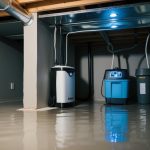Basement Makeovers: DIY Waterproofing Solutions for a Dry, Cozy Space
Design Considerations for Finished Basements
When transforming a basement into a livable area, it’s essential to manage moisture effectively. Proper material selection and functional design can create a comfortable environment that serves diverse purposes such as a bar or game room.
Choosing Moisture-Resistant Materials
Selecting appropriate materials is crucial in finished basements. Moisture-resistant materials ensure durability and comfort, even in a dry basement environment. Basement flooring options like vinyl and ceramic tiles are excellent choices as they withstand dampness better than traditional carpeting. For those who prefer carpeting, choosing synthetic fibers or moisture-resistant padding can be beneficial.
Maintaining a consistent finish throughout the basement helps provide a cohesive look. Wall panels made from PVC or fiberglass are highly resistant to water damage, making them ideal for basements. Considering sealants and moisture-resistant paints further aids in safeguarding against possible mold and water intrusion. Each material choice impacts the longevity and aesthetic of the space, emphasizing the need for informed decisions.
Incorporating Functional Design for Living Spaces
Designing a finished basement that serves multiple purposes requires innovative layout planning. Space utilization is key, with zones for activities like a bar or a game room clearly defined. Using partitions or open shelving can create distinct areas while preserving openness. The lighting is also crucial, with a mix of ambient and task lighting enhancing the basement’s appeal and functionality.
Furniture choices can significantly impact how the space is used. Opt for multi-use pieces such as foldaway chairs and tables to maximize utility in limited areas. Consider low moisture-absorbent materials for furnishings to mitigate potential humidity-related issues. By combining thoughtful design with practical solutions, the basement becomes a versatile extension of the home.
Identifying and Fixing Common Basement Leaks
Basement leaks often originate from various sources, such as plumbing leaks. A deteriorating pipe or an improperly sealed joint can lead to noticeable water accumulation. To address this, inspecting pipes regularly and replacing worn-out sections is essential to prevent plumbing failure.
Another common issue is basement flooding due to groundwater seepage. When heavy rains cause water to pool around the foundation, it can seep through cracks. This requires sealing cracks with waterproofing sealants and ensuring proper drainage away from the house.
Faulty window wells can also be a source of water entry. Inadequate drainage or damaged seals can result in basement floods. Ensuring that window wells are clear of debris and installing covers can mitigate this risk.
It’s crucial to check gutters and downspouts for blockages. Clogged gutters can overflow, causing water to run down the walls and lead to interior leaks. Regular cleaning is necessary to maintain proper water diversion.
Basements may experience moisture through condensation rather than leaks. High humidity levels can lead to a damp environment. Using a dehumidifier helps reduce moisture accumulation and keeps the space comfortable.
In any basement repair project, a detailed inspection is vital. Identifying potential entry points, such as cracks or gaps, aids in selecting the correct waterproofing solution. Homeowners should also consider consulting professionals for persistent issues to ensure a dry and cozy space.



